The Peerage of the United Kingdom is one of the five Peerages in the United Kingdom. It comprises most peerages created in the United Kingdom of Great Britain and Ireland after the Acts of Union in 1801, when it replaced the Peerage of Great Britain. New peers continued to be created in the Peerage of Ireland until 1898.

Baron Vaux of Harrowden is a title in the Peerage of England. It was created in 1523 for Sir Nicholas Vaux. The barony was created by writ, which means that it can pass through both male and female lines. Vaux was succeeded by his son, the second Baron. He was a poet and member of the courts of Henry VIII and Edward VI. The Vaux family was related to queen consort Catherine Parr by the first baron's two wives; Elizabeth FitzHugh and Anne Green. On the death in 1663 of his great-grandson, the fifth Baron, the title fell into abeyance between the late Baron's surviving sister Joyce, and the heirs of his deceased sisters Mary, Lady Symeon, and Catherine, Baroness Abergavenny.
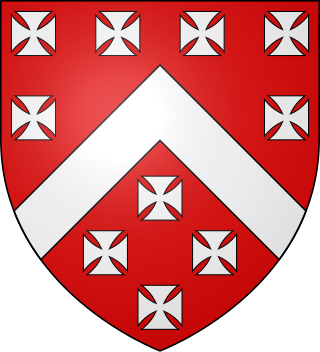
The title Baron Berkeley originated as a feudal title and was subsequently created twice in the Peerage of England by writ. It was first granted by writ to Thomas de Berkeley, 1st Baron Berkeley (1245–1321), 6th feudal Baron Berkeley, in 1295, but the title of that creation became extinct at the death of his great-great-grandson, the fifth Baron by writ, when no male heirs to the barony by writ remained, although the feudal barony continued. The next creation by writ was in 1421, for the last baron's nephew and heir James Berkeley. His son and successor William was created Viscount Berkeley in 1481, Earl of Nottingham in 1483, and Marquess of Berkeley in 1488. He had no surviving male issue, so the Marquessate and his other non-inherited titles became extinct on his death in 1491, whilst the barony passed de jure to his younger brother Maurice. However, William had disinherited Maurice because he considered him to have brought shame on the noble House of Berkeley by marrying beneath his status to Isabel, daughter of Philip Mead of Wraxhall, an Alderman and Mayor of Bristol. Instead, he bequeathed the castle, lands and lordships comprising the Barony of Berkeley to King Henry VII and his heirs male, failing which to descend to William's own rightful heirs. Thus on the death of King Edward VI in 1553, Henry VII's unmarried grandson, the Berkeley inheritance returned to the family. Therefore, Maurice and his descendants from 1492 to 1553 were de jure barons only, until the return of the title to the senior heir Henry, becoming de facto 7th Baron in 1553. Upon his death he was succeeded by his relative George Harding.

Baron Dudley is a title in the Peerage of England. It was created circa 1440 for John Sutton, a soldier who served as Lord Lieutenant of Ireland. The title descended in the Sutton family until the 17th century when Frances Sutton, the heir apparent to the title, married Humble Ward who was granted the title Baron Ward in 1644. Their heirs inherited both titles until 1740 when the differing rules of inheritance meant that the Barony of Dudley descended on Ferdinando Dudley Lea, who became the 11th Baron whilst the Barony of Ward went to John Ward, who later became 1st Viscount Dudley and Ward. On Ferdinando's death in 1757, the title fell into abeyance. The title was revived in 1916.
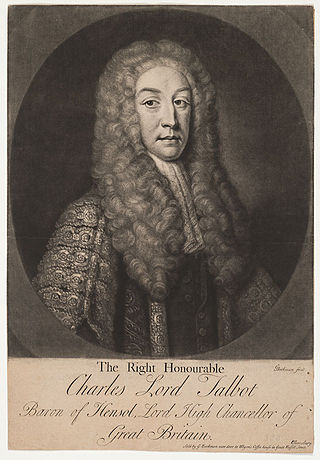
Earl Talbot is a title that has been created twice in the Peerage of Great Britain. This branch of the Talbot family descends from the Hon. Sir Gilbert Talbot, third son of John Talbot, 2nd Earl of Shrewsbury. His great-great-great-grandson, the Right Reverend William Talbot, was Bishop of Oxford, of Salisbury and of Durham. His eldest son Charles Talbot was a prominent lawyer and politician. In 1733, he was raised to the Peerage of Great Britain as Lord Talbot, Baron of Hensol, in the County of Glamorgan, and then served as Lord High Chancellor of Great Britain from 1733 to 1737.
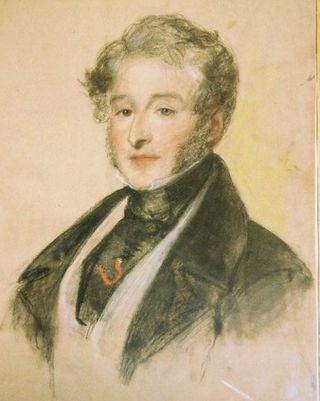
Baron Dinevor, of Dinevor in the County of Carmarthen, is a title in the Peerage of Great Britain. It was created on 17 October 1780 for William Talbot, 1st Earl Talbot, with remainder to his daughter, Lady Cecil, wife of George Rice, a member of a prominent Welsh family. On Lord Talbot's death the earldom became extinct because he left no sons to succeed to it, while the barony of Talbot also held by him was inherited by his nephew. The barony of Dynevor passed according to the special remainder to his daughter, the second holder of the title. In 1787 Lady Dynevor assumed by Royal licence the surname of de Cardonnel in lieu of Rice.

There have been three baronies created for the Gerard family who lived historically at Bryn, Ashton-in-Makerfield, Lancashire and Kingsley, Cheshire, in the 13th century. The third and current barony was created in 1876.

Baron Sandhurst, of Sandhurst in the County of Berkshire, is a title in the Peerage of the United Kingdom. It was created on 28 March 1871 for the soldier Sir William Mansfield, Commander-in-Chief of India between 1865 and 1870 and Commander-in-Chief of Ireland between 1870 and 1875. He was the grandson of Sir James Mansfield, Solicitor-General and Chief Justice of the Common Pleas. Lord Sandhurst's eldest son, the second Baron, was a Liberal politician and also served as Governor of Bombay. On 1 January 1917 he was created Viscount Sandhurst, of Sandhurst in the County of Berkshire, in the Peerage of the United Kingdom. However, he had no surviving male issue and on his death in 1921 the viscountcy became extinct. He was succeeded in the barony by his younger brother, the third Baron. As of 2021 the title is held by the latter's great-grandson, the sixth Baron, who succeeded his father in 2002. He is a barrister and judge and was elected to a hereditary-peers' seat in the House of Lords in 2021.

Baron Hunsdon is a title that has been created three times.
William Talbot, 1st Earl Talbot, PC, styled as Lord Talbot from 1737 to 1761, was an English peer and Whig politician. Talbot was a notable figure among opposition Whig politicians during the reign of King George II before later coming to Court during the reign of his grandson, taking the office of Lord Steward of the Household.

Walter FitzUryan Rice, 7th Baron Dynevor was a British military officer, civil servant and Conservative politician. He was the only son and heir of the 6th Baron Dynevor.

Cecil de Cardonnel, 2nd Baroness Dynevor was a Welsh peeress.

George Talbot Rice, 3rd Baron Dynevor (Dinefwr) was a British peer and politician. He was the son of Cecil de Cardonnel, 2nd Baroness Dynevor and George Rice. He was educated at Westminster School and matriculated at Christ Church, Oxford on 1 February 1783, where he was awarded a Master of Arts degree on 30 May 1786.

George Rice-Trevor, 4th Baron Dynevor was a British politician and peer.
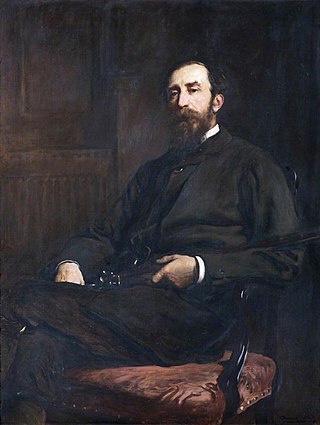
Arthur de Cardonnel FitzUryan Rice, 6th Baron Dynevor, was a British peer.

Charles Arthur Uryan Rhys, 8th Baron Dynevor CBE, was a British peer and politician. He was the son of Walter FitzUryan Rice, 7th Baron Dynevor.
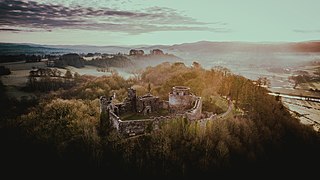
Dinefwr Castle is a ruined castle overlooking the River Towy near the town of Llandeilo, Carmarthenshire, Wales. It lies on a ridge on the northern bank of the Towy, with a steep drop of one hundred feet to the river. Dinefwr was the chief seat of the Dinefwr dynasty of the Kingdom of Deheubarth. The castle is a Grade I listed building.
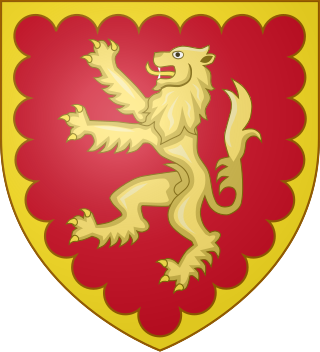
The Royal House of Dinefwr was a cadet branch of the Royal House of Gwynedd, founded by King Cadell ap Rhodri, son of Rhodri the Great. Their ancestor, Cunedda Wledig, born in late Roman Britain, was a Sub-Roman warlord who founded the Kingdom of Gwynedd during the 5th century, following the Anglo-Saxon settlement of Britain. As Celtic Britons, the House of Dinefwr was ruling before the Norman conquest, having to fight with their neighbors such as the Celtics, Anglo-Saxons and Vikings, before struggling with the Normans afterwards. Many members of this family were influential in Welsh history, such as Hywel Dda, who codified Welsh law under his rule, and achieved the important title of King of the Britons, or Lord Rhys, Prince of Wales, who rebelled against Richard the Lionheart, and became one of the most powerful Welsh leaders of the Middle ages.
Anthony David Brand, 6th Viscount Hampden DL was a British stock broker, Sussex land owner, South Downsman, hereditary peer and land agent.
Sir Charles John FitzRoy Rhys Wingfield was a British diplomat who was envoy to several countries.















